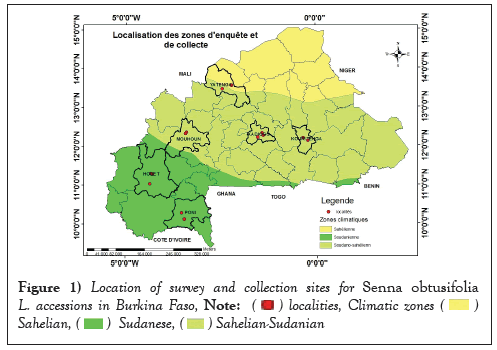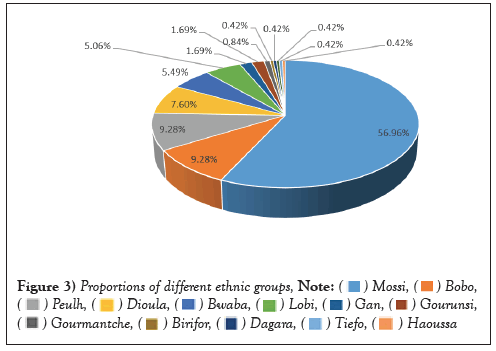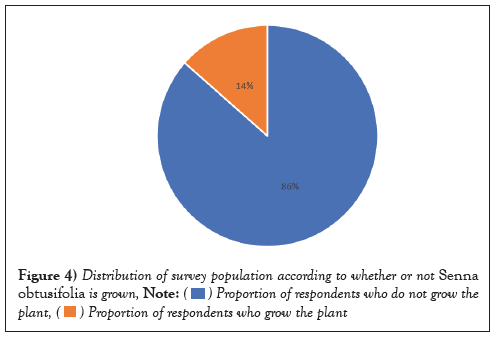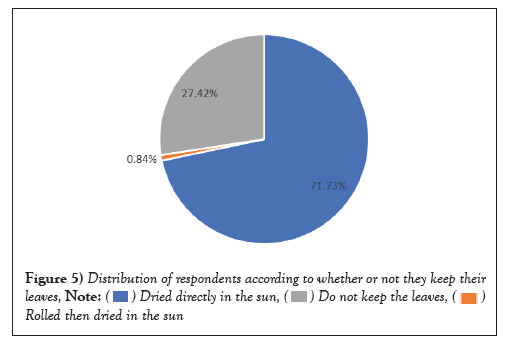Agricultural and Biological Research
RNI # 24/103/2012-R1
Research Article - (2024) Volume 40, Issue 1
Domestication of Senna obtusifolia could contribute to strengthening food security, empowering people and improving their living conditions, especially women, through the sale of leaves and seeds. However, very few studies have been devoted to the species in Burkina Faso, and it remains poorly known and still grows in the wild. The present study, whose general objective is to determine the state of domestication of Senna obtusifolia, will lay the scientific foundations for its domestication for the well-being of the population. The survey carried out made it possible to gather local knowledge about its domestication. The survey unit was the household. Fourteen ethnic groups were interviewed in 237 households. Domestication of Senna obtusifolia began in the villages of Sissamba and Namissiguima in the northern region, and Loropeni and Kampti in the south-western region. Its domestication would help create jobs at lower cost.
Senna obtusifolia; Status; Domestication; Conservation; Burkina Faso
Africa is endowed with a great diversity of food plants. Among these are the traditional leafy vegetables [1,2]. Some vegetable species are cultivated, but many others grow wild and are harvested. According to Dansi et al., [3] as with yams, all traditional cultivated leafy vegetables have been domesticated from wild species. Senna obtusifolia, also known as fetid cassia in French, krikri in Dioula and Katr-nanguri in Moore, is one such wild-harvested species, and very few studies have been devoted to it in Burkina Faso. As a result, it remains poorly known and neglected in the wild. Among the studies carried out on the species in Burkina Faso, we can mainly cite its medicinal role [4] its biochemical composition [5] ethnobotanical study [6], agro morphological characterization [7], assessment of its competitive capacity as an invasive species, [8] and evaluation of its genetic diversity [9]. Senna obtusifolia is an annual or perennial herb with an erect, branched stem reaching an average height of 2.5 m, and alternate pinnate leaves [10,11]. It is thought to originate in tropical South America, but is widespread in all tropical and subtropical regions of Africa, America, Asia, Australia, Europe and Oceania [12-16]. Its leaves are used as a vegetable in Africa and Asia and are rich in protein, fibre and minerals [17,18]. The presence of several biochemical compounds in Senna obtusifolia L. gives it several biochemical properties, including antioxidant, anti-microbial, antidiabetic, anti-inflammatory, immunostimulant, anti-proliferative, hypolipolipidic and antitumor activities [19]. In Burkina Faso, the leaves are used against night blindness, hepatitis, jaundice and venomous insect bites. The seeds are used against venomous insect bites, coughs, and the roots against snake bites and urinary tract infections [4,6]. The sale of Kawal, made from these leaves, as well as the sale of fresh or dried leaves by women in Niger's Aguie department, generate income for stakeholders [5,20]. Moreover, like all traditional leafy vegetables, it is available, adapted to our agro ecological conditions and has a low production cost [21]. Given the plant's economic, dietary, nutritional and medicinal importance, especially for low-income rural communities, and like all traditional leafy vegetables, according to Dansi et al., [3] intensifying its use and improving its quality and productivity are undoubtedly alternative solutions to preserving their biodiversity, solving the problems of undernourishment and improving people's standard of living. What's more, when it comes to valorizing genetic resources, their transition from the status of wild plants to that of cultivated plants necessarily involves research. To date, however, the species has not been cultivated, and is essentially exploited by women under natural conditions. Today, the galloping growth of the population and the ever increasing demand for food and space are having an impact on the dynamics and sustainability of Senna obtusifolia. It is in response to this concern that this study was initiated, with the general aim of establishing the state of domestication of Senna obtusifolia, in order to lay the scientific foundations for its domestication, conservation and development for the well-being of the population. Specifically, the aim was to:
• Identify local knowledge of the plant's domestication.
• Identify local knowledge of how to obtain the leaves.
• Identify local knowledge of leaf conservation.
• Use a survey-collection method to collect seeds that could be used to assess the species genetic diversity.
Survey and collection area
Burkina Faso has a Sudan-Sahelian climate [22,23]. From north to south, three climatic zones can be distinguished:
• The Sahelian zone, located north of latitude 14 degrees north, with rainfall below 600 mm. The rainy season in this zone is very short, barely covering two to three months, and average temperatures are above 30°C. This is the least watered zone in the country.
• The Soudano-Sahelian zone, between 11 degrees 30' and 14-degrees north latitude, with rainfall varying between 600 mm and 900 mm. The climate is North Sudanian. It is characterized by a rainy season lasting four to five months and average temperatures of between 20 and 30°C.
• The Sudanian zone located south of 11 degrees 30' north latitude, with a rainfall of over 900 mm. The climate is Sudanian. In this zone, the rainy season lasts five to six months, with average annual temperatures ranging from 20 to 25°C. This is the country's wettest zone.
The study was carried out in six provinces in Burkina Faso's three climatic zones. These were the provinces of Houet and Poni in the Sudanian zone, Mouhoun, Kadiogo and Kouritenga in the Sudano-Sahelian zone; and the province of Yatenga in the Sahelian zone. In each province, two villages were chosen, taking into account their accessibility in all seasons and the low level of development for the survey. A total of 12 villages were selected (Figure 1). These were Banakeledaga and Darsalamy in Houet province, Kampti and Loropeni in Poni province, Fakouna and Lonkakuy in Mouhoun province, Saaba and Garghin in Kadiogo province, Bassem-Poessin and Koudmi in Kouritenga province, and Sissamba and Namissiguima in Yatenga province.

Figure 1: Location of survey and collection sites for Senna obtusifolia L. accessions in Burkina Faso, 
 .
.
Ethnobotanical survey
Data were collected through individual surveys. The survey unit was the household. The survey method used was individual interviews with a member of the household. For data collection, a survey form was sent to each household. The information collected mainly concerned parameters such as the sex and age of the respondent, the method of obtaining the leaves, the methods of conservation and the domestication status of the plant. Households in each village were selected at random. Twenty (20) households were selected per village.
Accessions collection
In addition to the twelve villages where the survey takes place, seed was also collected in Saouileni in Houet province, Tanlarghin in Kadiogo province and sector 14 of Bobo-Dioulasso on outing occasions during which we encounter large tracts of land occupied by the species. In all localities, seeds were collected in the wild by taking samples of the various accessions on different types of soil.
Data analysis
The data collected during the survey, which was essentially qualitative, was analysed using descriptive statistics. The results of the analysis were represented in the form of tables and graphs using Excel 2016 spreadsheet and Arc Gis 2012 software. The data were first entered and then processed using Excel 2016 spreadsheet software. After processing, the data was used to calculate frequencies using the same spreadsheet. It was also used to construct the various histograms and diagrams. Arc Gis 2012 was used to construct the map showing the location of survey sites and accessions of Senna obtusifolia.
Survey results
Socio-demographic characteristics of the survey population: A total of 240 households were surveyed; however, the records of three households were discarded during the analysis due to incomplete information, so that 237 households were retained for the study. The survey population was made up of 39.24% men and 60.75% women. The majority were women, with ages ranging from 15 to 95 (Figure 2). The population is relatively young, with 62.86% aged between 15 and 45 and 37.13% aged between 45 and 95.

Figure 2: Age distribution of respondents, 

 .
.
Distribution of respondents by ethnic group: Among the 237 households surveyed in the course of this study, fourteen (14) ethnic groups were encountered, of which more than half i.e., 56.96% of households, belonged to the Mossi ethnic group, while the remaining 43.04% represented other ethnic groups (Figure 3).

Figure 3: Proportions of different ethnic groups, 

 .
.
Domestication status and leaf harvesting methods: Of the 237 households surveyed, the majority (86.49%) harvest Senna obtusifolia leaves in the wild, or the species is considered a weed. Only 13.50% of the population surveyed cultivate the plant (Figure 4), with the aim of improving the quantity and quality of the leaves for self-consumption or sale. And also, to bring the plant closer to people's homes. This is the beginning of domestication. Domestication of the species has begun in the northern region (Sissamba and Namissiguima) and the south-western region (Loropeni and Kampti). The remaining 86.5% think it's a waste of time to domesticate a plant that grows abundantly in the wild.

Figure 4: Distribution of survey population according to whether or not Senna
obtusifolia is grown, 
 .
.
Post-harvest leaf preservation
Harvested leaves are consumed either fresh or dried. Indeed, during the rainy season, when leaves are abundant, part of the harvest is eaten fresh, and the surplus is dried and eaten during the dry period by the majority of respondents (72.57%). The leaves are either dried directly in the sun (71.73%), or boiled (0.84%) before being dried in the sun and then stored in bags or jars. However, 27.42% of respondents do not keep the plant, and therefore only consume it during the rainy season (Figure 5). An analysis of the distribution of respondents according to storage methods shows that, depending on the region, all respondents (100%) store leaves in the North and Loop du Mouhoun regions, whereas in the Upper Basins, South-West and Central-East regions, the storage percentages are 95%, 70% and 40% respectively.

Figure 5: Distribution of respondents according to whether or not they keep their
leaves, 
 .
.
Collection of Senna obtusifolia L. accessions
A total of 132 accessions of Senna obtusifolia L. were collected throughout the study area. These included 22 (16.66%) accessions from the Sahelian zone, 68 (51.51%) accessions from the Sudano-Sahelian zone and 42 (31.81%) accessions from the Sudanian zone. The majority of accessions are from the Sudano-Sahelian zone.
Senna obtusifolia L. is a seasonal plant that grows spontaneously in the wild at the first rains. However, the leaves used for food are perishable and cannot be preserved for long. As a result, women have developed techniques for drying and preserving the leaves, so that they can be used at any time of the year. They either dry the leaves directly in the sun, or boil them before drying and storing them in jars or bags. Similar preservation techniques have been observed in Senegal by Diouf et al., [24] in Togo by Batawila et al., [25] on leafy vegetables and in Burkina Faso by Kiebre [26] on Corchorus olitorius. The high proportion of women encountered in this survey (60.75%) could be explained by the fact that they are mostly housewives. They work in the fields and look after vegetable issues in their households. Indeed, according to Chweya et al., [27] the production, harvesting, domestication, marketing, preservation and use of leafy vegetables are essentially female activities.
Domestication is the passage of a plant from wild to cultivated status. Once domesticated, the plant is then constantly available and sustainably used. More than half the people surveyed thought that domesticating a species that grew in the wild was a waste of time. Only respondents from Sissamba and Namissiguima in the northern region, and Loropeni and Kampti in the south-western region (13.5%) have begun domestication. These people say they want to increase the quantity and quality of their leaves for consumption and sale. They also want to bring the plant closer to home. Similar results were observed by Adjatin [28] on traditional leafy vegetables in Benin. Such a practice is not without interest, since it allows plants to be organized rather than left to grow randomly. It also improves quality, as agricultural practices such as seed selection, maintenance and manuring can be undertaken.
According to Dansi et al., [3] given the economic, nutritional and medicinal importance of traditional leafy vegetables, especially for low-income rural communities, intensifying their use and improving their quality and productivity are undoubtedly alternative solutions for preserving their biodiversity, solving the problems of undernourishment and improving people's standard of living. In addition, domestication of the species would contribute to the development of urban and peri urban market gardening, which according to Yappi [29] is a survival activity for many households. This would enable the most disadvantaged households to obtain fresh vegetables and improve the protein and vitamin value of their meals, while saving money [30-32]. The domestication of Senna obtusifolia could therefore contribute to strengthening the food security of populations, empowering and improving living conditions, especially for women, through the sale of leaves. Similar results were obtained in Niger's Aguie department as part of a program that supported women in the domestication of Senna obtusifolia to reduce the food difficulties encountered at certain times of the season [20]. A study carried out on Senna obtusifolia by Bori et al., [33] highlighted the existence of significant leaf production potential with staggered harvests under irrigated cultivation in the Niger Sahel, Niger. According to Pasternak et al., [17] in 2006, two series of trials were carried out at International Crops Research Institute for the Semi-Arid Tropics (ICRISAT) Sadore station to assess the potential of Senna obtusifolia as a new rain fed crop for the Sahel. The high density planting (0.5 × 0.5 m) gave significantly higher leaf, seed and stem yields (1, 1 and 2.5 t/ha respectively) on a dry matter basis than the lower density treatments. Preliminary studies carried out by Dan Guimbo et al., [34] on the food use of spontaneous plants in the outlying areas of Niger's Parc W showed that the species fresh and dried leaves are increasingly being sold on rural markets and even exported to major urban centers.
Domestication is achieved through the identification of an optimum production density and seed multiplication. According to Dansi et al., [3] in the traditional system, the domestication of a species requires a long trial period by growers. To speed this up, multidisciplinary research programs need to be developed and conducted, including, for a given species, an understanding of its reproductive biology, knowledge of diseases and pests and their control, and the development of an appropriate technological package for cultivation practices. This justifies the collection of seeds, which have undergone an initial agro morphological evaluation by Nacambo et al., [7] and will be used for further evaluations to gain a better understanding of all these aspects of the plant. At the end of this stage, it will be possible to provide the population with adapted varieties, according to their needs, as the plant can be cultivated for its seeds as well as its leaves. What's more, when there are several useful varieties, choosing the best one to domesticate can be difficult for the population. Similar conclusions were drawn by Du Priez et al., [35].
Senna obtusifolia, like all traditional leafy vegetables, is well adapted to local soil and climate conditions, and is less demanding in terms of inputs and water than exotic vegetables whose seeds are not always accessible. Financial investment in its production would therefore be virtually nil. Its domestication would also help to create jobs at lower cost.
Neither leaf preservation techniques nor the plant's domestication status have varied from one ethnic group to another, which could be explained by cultural inter-mingling, as Batawila [36] explains with regard to eating habits. According to him, there are cases where eating habits can be acquired through cultural mixing.
The study revealed two main techniques for preserving Senna obtusifolia leaves among the population surveyed. The leaves are either dried directly in the sun, or boiled before being dried and preserved for later use.
Domestication began only in the villages of Sissamba and Namissiguima in the northern region, and Loropeni and Kampti in the south-western region. Neither leaf storage methods nor domestication varied according to ethnic group. The domestication of Senna obtusifolia could contribute to strengthening local food security, empowering local populations and improving living conditions, especially for women, through the sale of the plant's leaves. It would also contribute to the development of urban and peri urban market gardening and the creation of low-cost jobs. However, domestication of the plant requires a thorough understanding of its biology, knowledge of its enemies and pests, and the development of appropriate technologies for cultivation practices. Hence the importance of other studies such as agro-morphological evaluation, which will enable us to gain a better understanding of the plant. Nutritional and toxicological analyses of Senna obtusifolia leaves should also be carried out.
The authors acknowledge the members of “Laboratoire Biosciences” for their assistance.
This work was carried out in collaboration among all the authors. The first author designed the experiment and analyzed the data. All the authors interpreted the data, read the final manuscript, and agreed with all contents.
[Crossref]
[Crossref] [Google Scholar] [PubMed]
[Crossref] [Google Scholar] [PubMed]
Citation: Nacambo H, Ouedraogo MH, Ouangraoua JW, et al. Status of the domestication of Senna obtusifolia (L.) Irwin and barneby in some localities of Burkina Faso. AGBIR.2024;40(1):755-758.
Received: 04-Dec-2023, Manuscript No. AGBIR-23-121859; , Pre QC No. AGBIR-23-121859 (PQ); Editor assigned: 07-Dec-2023, Pre QC No. AGBIR-23-121859 (PQ); Reviewed: 25-Dec-2023, QC No. AGBIR-23-121859; Revised: 02-Jan-2024, Manuscript No. AGBIR-23-121859 (R); Published: 09-Jan-2024, DOI: 10.35248/0970-1907.24.40.755-758
Copyright: This open-access article is distributed under the terms of the Creative Commons Attribution Non-Commercial License (CC BY-NC) (http:// creativecommons.org/licenses/by-nc/4.0/), which permits reuse, distribution and reproduction of the article, provided that the original work is properly cited and the reuse is restricted to noncommercial purposes. For commercial reuse, contact reprints@pulsus.com This is an open access article distributed under the terms of the Creative Commons Attribution License, which permits unrestricted use, distribution, and reproduction in any medium, provided the original work is properly cited.
